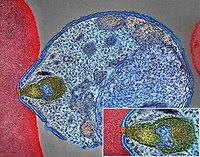
Photo from wikipedia
Background: Malaria infection is reportedly linked to endemic Burkitt lymphoma (eBL) in malaria-endemic areas. This study aimed to pool the overall risk (or odds) of eBL among children with previous… Click to show full abstract
Background: Malaria infection is reportedly linked to endemic Burkitt lymphoma (eBL) in malaria-endemic areas. This study aimed to pool the overall risk (or odds) of eBL among children with previous or concurrent malaria infection. Methods: We searched PubMed, Web of Science, Scopus, and reference lists of publications for potentially relevant studies on malaria infection and eBL. The quality of the included studies was assessed using the Joanna Briggs Institute for case-control studies. Random-effects meta-analysis was used to summarize whether the odds of eBL can be increased by (1) malaria infection or (2) elevated titer of IgGs to malaria antigen. The level of heterogeneity was evaluated using Cochran’s Q statistic and I2. The individual study data, pooled odds, and confidence interval (CI) were illustrated using the forest plot. Publication bias was assessed using funnel plots and Egger’s test. Results: Ten studies were included, reporting the number of malaria cases in eBL and non-eBL (5 studied malaria infection and the odds of eBL; five studied the burden of IgGs to malarial antigens and the odds of eBL). According to the meta-analysis results, the odds of eBL was not increased by malaria infection (p = 0.562, OR: 0.87, 95% CI: 0.54–1.39, I2: 93.5%, malaria in eBL: 604/1506 cases, malaria in non-eBL: 2117/4549 cases) and the elevated titer of IgGs to malaria antigen (p = 0.051, OR: 1.50, 95% CI: 1.00–2.25, I2: 89%, increased IgG titer in eBL: 1059/1736 cases, increased IgG titer in non-eBL: 847/1722 cases). In meta-regression analysis, sex was not a confounding factor for the effect size of malaria infection and eBL (p = 0.10) and that of increased IgGs and eBL (p = 0.80). Conclusions: Malaria infection and IgG titer elevation did not increase the risk for eBL among children. However, the included studies, which are only few, do not generally agree on this point. Therefore, the risk for eBL in children diagnosed with malaria should be investigated further by longitudinal studies to confirm our evidence-based approach.
Journal Title: International Journal of Environmental Research and Public Health
Year Published: 2021
Link to full text (if available)
Share on Social Media: Sign Up to like & get
recommendations!